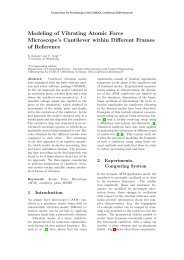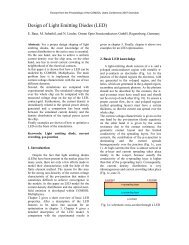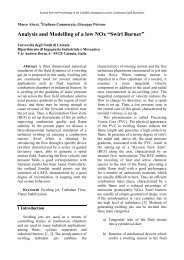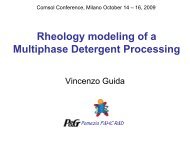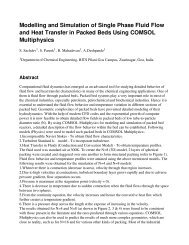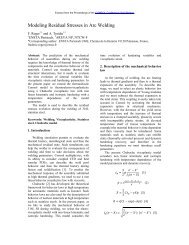Thermo-mechanical simulation of a laboratory test ... - COMSOL.com
Thermo-mechanical simulation of a laboratory test ... - COMSOL.com
Thermo-mechanical simulation of a laboratory test ... - COMSOL.com
Create successful ePaper yourself
Turn your PDF publications into a flip-book with our unique Google optimized e-Paper software.
<strong>Thermo</strong>-<strong>mechanical</strong> <strong>simulation</strong> <strong>of</strong> a <strong>laboratory</strong> <strong>test</strong><br />
to determine <strong>mechanical</strong> properties <strong>of</strong> steel near the<br />
solidus temperature<br />
Jürgen Reiter und Robert Pierer<br />
Christian Doppler Laboratory for Metallurgical Fundamentals <strong>of</strong> Continuous Casting<br />
Processes (CDL-MCC), Franz-Josef-Straße 15, A-8700 Leoben, Austria, juergen.reiter@muleoben.at<br />
1 Introduction<br />
Continuous casting (CC) is nowadays the dominating technology in the transformation from<br />
liquid to solid steel. 90% <strong>of</strong> the annual worldwide production <strong>of</strong> more than 1 billion tons are<br />
produced via the continuous casting process. Although CC is a widely optimised technology,<br />
increasing demands on product quality and the basic necessity <strong>of</strong> higher economical and<br />
ecological efficiency lead to a continuous enhancement <strong>of</strong> the process.<br />
The right side <strong>of</strong> fig. 1 shows a schematic diagram <strong>of</strong> the CC process. The liquid steel is cast<br />
into a water-cooled copper mould, where a thin shell solidifies around the liquid metal. In<br />
contrast with other metals, like e.g. aluminium, solid steel is a relatively poor heat conductor.<br />
This reduces the heat removal from the surface and leads to an extremely long solidification<br />
time. The distance between the mould and the point <strong>of</strong> total solidification extends to more<br />
than 35 m in slab casting. This makes it necessary to bend and straighten the partially<br />
solidified strand in order to minimize the height <strong>of</strong> the casting machine. As the solidified steel<br />
is very crack sensitive in certain temperature ranges, this deformation may be the reason for<br />
defect formation. The process-sure prevention <strong>of</strong> defect formation demands for detailed<br />
knowledge <strong>of</strong> the casting process and the properties <strong>of</strong> the cast material.<br />
For this reason, the <strong>com</strong>bination <strong>of</strong> numerical and experimental <strong>simulation</strong> is a very<br />
promising way. The present paper describes a <strong>laboratory</strong> <strong>test</strong> method, the so-called<br />
Submerged Split-Chill Tensile (SSCT) <strong>test</strong>, which allows a process-near tensile <strong>test</strong> on<br />
solidifying steel in order to estimate the strength and the crack susceptibility <strong>of</strong> the strand<br />
shell. This <strong>test</strong> has been thermo-<strong>mechanical</strong>ly modelled, using the FEMLAB s<strong>of</strong>tware<br />
package. The model allows, among other things, the adjustment <strong>of</strong> parameters in constitutive<br />
material laws to the <strong>test</strong> results. The resulting material properties, characteristic for the<br />
behaviour <strong>of</strong> steel under CC conditions and specific for every steel <strong>com</strong>position, are an<br />
important input for the numerical <strong>simulation</strong> <strong>of</strong> the CC process.<br />
2 Experiment<br />
Excerpt from the Proceedings <strong>of</strong> the <strong>COMSOL</strong> Multiphysics User's Conference 2005 Frankfurt<br />
Fig. 1 shows a schematic view <strong>of</strong> the SSCT <strong>test</strong> method (Bernhard et al. 1996) and the<br />
solidification conditions <strong>com</strong>pared to the continuous casting process. A solid steel <strong>test</strong> body,<br />
split in two halves, is submerged into the liquid melt in an induction furnace. The surface <strong>of</strong><br />
the <strong>test</strong> body is spray-coated with a thin zirconium oxide layer in order to control the cooling<br />
rate (CR) and to minimize friction. A steel shell solidifies around the <strong>test</strong> body with the main<br />
crystallographic orientation perpendicular to the interface, similar to the situation in a<br />
continuous casting mould. The force between the upper and lower part <strong>of</strong> the <strong>test</strong> dummy is<br />
measured by a load cell, the position <strong>of</strong> the lower part by an inductive position sensor. A<br />
servo-hydraulic controller controls force and position. This allows a number <strong>of</strong> different<br />
<strong>test</strong>ing procedures, including the hot tensile <strong>test</strong>, in which, after a certain holding time, the
lower half <strong>of</strong> the <strong>test</strong> body is moved downwards at a controlled velocity at strain rates (SR)<br />
typically between 10 -3 and 10 -2 s -1 , while the necessary tensile force is recorded.<br />
The calculations presented in this paper refer to two SSCT <strong>test</strong> series. The first was<br />
performed at varying temperatures (holding times), cooling rates (coating thicknesses) and<br />
strain rates and the second one with different steel <strong>com</strong>positions (carbon content from 0.05%<br />
to 0.70%).<br />
Force, kN<br />
Excerpt from the Proceedings <strong>of</strong> the <strong>COMSOL</strong> Multiphysics User's Conference 2005 Frankfurt<br />
Elongation, mm<br />
Solidified<br />
shell<br />
Upper<br />
part<br />
Lower<br />
part<br />
Fig. 1. The SSCT <strong>test</strong>, schematic and solidification conditions during the <strong>laboratory</strong> <strong>test</strong> and the CC<br />
process.<br />
3 The FEMLAB model<br />
Melt<br />
Mushy zone<br />
For a detailed analysis <strong>of</strong> the SSCT <strong>test</strong> two FEMLAB application modes are necessary:<br />
Firstly, the solidification <strong>of</strong> the steel shell around the <strong>test</strong> body inside the induction furnace is<br />
solely a heat transfer problem and can be solved with the corresponding application mode.<br />
Secondly, the <strong>simulation</strong> <strong>of</strong> the hot tensile <strong>test</strong> requires the structural mechanics module.<br />
With regard to the conditions during the SSCT <strong>test</strong> it is necessary to consider that, in contrast<br />
to the isothermal condition <strong>of</strong> the specimen during conventional hot tensile <strong>test</strong>ing, the SSCT<br />
<strong>test</strong> is a gradient <strong>test</strong> under unsteady state conditions. Due to the progress <strong>of</strong> solidification<br />
during the <strong>test</strong>, the shell thickness, and consequently the stressed cross-section are not<br />
constant but a function <strong>of</strong> time, similar to continuous casting. The temperature at the<br />
interface between the <strong>test</strong> body and the shell ranges between 1000 and 1300 °C at the end<br />
<strong>of</strong> <strong>test</strong>ing, depending on solidification time and cooling rate. This results in a time-dependent<br />
temperature distribution up to the solidus temperature inside the solidified steel shell. Hence,<br />
a coupled time-dependent thermo-<strong>mechanical</strong> analysis is essential with all necessary<br />
material parameters such as thermal conductivity (k in W/mK), density (ρ in kg/m 3 ), heat<br />
capacity (cP in J/kgK), Young’s modulus (E in N/m 2 ), Poisson’s ratio and the thermal<br />
expansion coefficient (α in K -1 ) defined as functions <strong>of</strong> temperature. In addition, elasto-plastic<br />
material data are necessary for an accurate analysis.<br />
The cylindrical geometry <strong>of</strong> the <strong>test</strong> body and the induction furnace allows the use <strong>of</strong> an<br />
axisymmetric 2D geometry for the realisation in FEMLAB. Thereby, only the domain <strong>of</strong> the<br />
melt is considered. The geometry and the mesh are shown in fig. 2, in which the mesh at the<br />
interface between the <strong>test</strong> body and the melt is refined because <strong>of</strong> the high temperature<br />
gradients at the interface.<br />
A transient analysis <strong>of</strong> heat transfer by conduction is used for the thermal analysis <strong>of</strong> the<br />
SSCT <strong>test</strong>. The necessary subdomain parameters thermal conductivity, density and heat<br />
capacity as functions <strong>of</strong> temperature were calculated using the s<strong>of</strong>tware package IDS<br />
(Miettienen 1997). When solidification occurs, it is very important to consider the latent heat
(LH in J/kg) <strong>of</strong> solidification in the heat transfer analysis. Therefore, the following equation is<br />
used to implement the latent heat by means <strong>of</strong> a modified heat capacity CP mod between the<br />
liquidus (TL) and solidus temperature (TS):<br />
c<br />
mod<br />
P<br />
Excerpt from the Proceedings <strong>of</strong> the <strong>COMSOL</strong> Multiphysics User's Conference 2005 Frankfurt<br />
∂f<br />
L<br />
( T ) = cP<br />
( T ) + LH<br />
∂T<br />
In equation (1), T denotes the temperature and fL the fraction <strong>of</strong> liquid, which was also<br />
calculated using the s<strong>of</strong>tware package IDS. The heat transfer needed for solving the thermal<br />
analysis <strong>of</strong> the problem is that occurring at the interface between the liquid melt and the solid<br />
steel <strong>test</strong> body. Seeing that the heat flux itself is difficult to measure in this environment, the<br />
temperature inside the <strong>test</strong> dummy is recorded throughout the experimental procedure. In<br />
order to further determine the removed heat from this measured temperature, an inverse<br />
algorithm for the solution <strong>of</strong> the heat-conduction equation is used (Michelic 2005). This<br />
algorithm has been developed in MATLAB and is generally based on a variation <strong>of</strong> a<br />
maximum-a-posteriori method which has been proposed by Beck 1977 and adjusted to a<br />
similar problem by Bass et al. 1980. The general objective <strong>of</strong> such an application is to reach<br />
closest agreement <strong>of</strong> measured and calculated temperature values by a variation <strong>of</strong> the timedependent<br />
heat-flux q. This is ac<strong>com</strong>plished by a minimization <strong>of</strong> the sum <strong>of</strong> difference<br />
squares S:<br />
N N<br />
t m<br />
2<br />
S(<br />
q)<br />
=<br />
⎡<br />
⎤<br />
∑ ∑ T<br />
m<br />
− T<br />
c<br />
( q)<br />
(2)<br />
⎢⎣ ij ij ⎥⎦<br />
i = 1j= 1<br />
Equation (2) considers Nm thermocouples at positions j, measuring the temperature T m at<br />
every timestep i (1
al. 1986, Sorimachi et al. 1977 and Kelly et al. 1988). However, it should be mentioned that<br />
at high temperatures the <strong>mechanical</strong> properties are very sensitive to the strain rate. The<br />
Ramberg-Osgood law provides elasto-plastic material data by isotropic hardening. Thereby<br />
the yield stress σyield is defined as a function <strong>of</strong> the plastic strain εP:<br />
σ ( ε ) ⋅ε<br />
yield<br />
p<br />
n<br />
= K p p ( t)<br />
(3)<br />
Equation (3) is used as the required hardening function in the elasto-plastic material settings,<br />
where KP and n are temperature-dependent material properties called the plastic resistance<br />
and the strain hardening exponent respectively. The procedure outlined by Uehara et al.<br />
1986 was applied to determine n, assuming KP to be constant. However, the <strong>com</strong>parison with<br />
own experimental results points at a significant temperature- and <strong>com</strong>position-dependence <strong>of</strong><br />
KP for a given strain rate (Pierer et al. 2005). Thereby, a simple thermo-<strong>mechanical</strong> model <strong>of</strong><br />
the SSCT <strong>test</strong> was developed to adjust high temperature <strong>mechanical</strong> properties to the SSCT<br />
<strong>test</strong>. A result <strong>of</strong> this model was the requirement <strong>of</strong> defining the plastic resistance as a<br />
function <strong>of</strong> temperature, strain rate and carbon content.<br />
For the temperature-dependent Young’s modulus different approaches can be found in the<br />
literature. All presented <strong>simulation</strong> results in this paper refer to the temperature-dependent<br />
Young´s modulus, proposed by Kinoshita et al 1979.<br />
In case <strong>of</strong> the hot tensile <strong>test</strong>ing the lower part <strong>of</strong> the <strong>test</strong> body is moved downwards with a<br />
predefined velocity to a certain elongation, which is controlled by the adjusted <strong>test</strong>ing time.<br />
The realisation <strong>of</strong> displacement in FEMLAB takes place by regulating the z-position <strong>of</strong> the<br />
horizontal interface between the <strong>test</strong> body and the melt as a function <strong>of</strong> time (see fig. 2). The<br />
determination <strong>of</strong> the force-elongation curve is carried out using the integration coupling<br />
variables function provided by the s<strong>of</strong>tware.<br />
ρ=f(T) c P=f(T)<br />
Thermal analysis<br />
k=f(T)<br />
Excerpt from the Proceedings <strong>of</strong> the <strong>COMSOL</strong> Multiphysics User's Conference 2005 Frankfurt<br />
q=f(t)<br />
Time dependent<br />
solver<br />
Temperature<br />
distribution<br />
Coupling<br />
RESULTS<br />
Mechanical analysis<br />
E=f(T)<br />
α=f(T)<br />
Fig. 3. Procedure <strong>of</strong> the FEMLAB <strong>simulation</strong> <strong>of</strong> the SSCT <strong>test</strong><br />
Elasto-plastic<br />
data<br />
ν=f(T)<br />
Parametric nonlinear<br />
solver<br />
RESULTS<br />
Stress and strain<br />
distribution<br />
Force elongation<br />
curve<br />
The procedure <strong>of</strong> the <strong>com</strong>plete <strong>simulation</strong> is shown in fig. 3, in which the two analysis models<br />
– thermal analysis by the heat transfer module and <strong>mechanical</strong> analysis by the structural<br />
mechanics module – are illustrated together with the necessary input data and solvers. To<br />
determine the shell thickness s(t) as a function <strong>of</strong> time the heat transfer problem has to be<br />
solved by transient analysis using the time-dependent solver. An accurate calculation <strong>of</strong> s(t)<br />
is very important, because the results <strong>of</strong> the experiment and, as a matter <strong>of</strong> course, the<br />
numerical calculations, strongly depend on the shell thickness. However, the <strong>mechanical</strong><br />
analysis using elasto-plastic material data can not be used for any type <strong>of</strong> transient<br />
problems, it can only be used together with the nonlinear parametric solver (FEMLAB 3<br />
Structural mechanics module, User’s guide 2004). Due to the necessity <strong>of</strong> these two different<br />
solvers, the coupling <strong>of</strong> the analysis is not possible at present. To consider the shell
thickness as a function <strong>of</strong> time and the temperature-dependency <strong>of</strong> the material data, the<br />
following procedure enables the analysis <strong>of</strong> the SSCT <strong>test</strong> in a sufficiently accurate manner:<br />
the temperature distribution as a function <strong>of</strong> time and as a result <strong>of</strong> the thermal analysis has<br />
been exported from the post processing subdomain data. Thereby a regular grid with<br />
300x200 points was used and saved as a text-file for defined time steps. The <strong>mechanical</strong><br />
analysis <strong>of</strong> the SSCT <strong>test</strong> imports these files using the interpolation function application <strong>of</strong><br />
the s<strong>of</strong>tware. This procedure is illustrated on top <strong>of</strong> fig. 3, whereby the temperaturedependent<br />
material data as well as the solidification process during the hot tensile <strong>test</strong> can<br />
be considered.<br />
4 Results<br />
Excerpt from the Proceedings <strong>of</strong> the <strong>COMSOL</strong> Multiphysics User's Conference 2005 Frankfurt<br />
To validate the thermal analysis, the calculated shell thickness at the end <strong>of</strong> <strong>test</strong>ing can be<br />
<strong>com</strong>pared with measurements <strong>of</strong> the solidified steel shell. Fig. 4a and 4b show the<br />
solidification process during the hot tensile <strong>test</strong>. The minimum and maximum values <strong>of</strong> the<br />
plotted temperature correspond to TS and TL, thus the illustrations show the mushy zone <strong>of</strong><br />
the solidified steel shell.<br />
a) Begin <strong>of</strong> <strong>test</strong>ing b) End <strong>of</strong> <strong>test</strong>ing<br />
T L=1515°C<br />
T S=1461°C<br />
8<br />
8 9 10 11 12 13 14<br />
Fig. 4. Shell thickness at the begin a) and end b) <strong>of</strong> <strong>test</strong>ing together with a <strong>com</strong>parison <strong>of</strong> calculated<br />
and measured shell thickness for the 0.16% carbon steels and the carbon <strong>test</strong> series (0.05 - 0.70%C)<br />
Fig. 4c shows the calculated over the measured shell thickness. The calculated values<br />
illustrated in the diagram in all cases refer to fS = 0.1 and show good agreement with the<br />
measured shell thickness. In addition, the scatter band <strong>of</strong> the measurements are illustrated<br />
for the four <strong>test</strong>s <strong>of</strong> the first series. Beside the temperature-dependent thermo-physical data,<br />
the thermal analysis depends on many other parameters such as the measured<br />
temperatures during the SSCT <strong>test</strong>: the steel bath temperature as an initial value for the<br />
<strong>simulation</strong> as well as the measured temperature increase inside the <strong>test</strong> body which is<br />
required for calculating the heat flux. As a matter <strong>of</strong> course, the accuracy <strong>of</strong> the <strong>simulation</strong> is<br />
influenced by the size and number <strong>of</strong> the elements (1585). To get <strong>com</strong>parable <strong>simulation</strong><br />
results the same mesh was used for all calculations. It can be summarised that the thermal<br />
analysis using the above described material data, boundary conditions and mesh describes<br />
the solidification <strong>of</strong> the steel shell.<br />
Fig. 5 shows the von Mises stress inside the solidified steel shell at the end <strong>of</strong> <strong>test</strong>ing<br />
resulting from the <strong>mechanical</strong> analysis. The picture refers to two <strong>test</strong>s <strong>of</strong> the first series with a<br />
Calculated shell thickness, mm<br />
14<br />
13<br />
12<br />
11<br />
10<br />
9<br />
c)<br />
High CR, low SR<br />
High CR, high SR<br />
Low CR, high SR<br />
Low CR, low SR<br />
Carbon <strong>test</strong> series<br />
Measured shell thickness, mm
holding time <strong>of</strong> 12 s, a strain rate <strong>of</strong> 2 . 10 -3 s -1 and two different cooling rates. In addition, the<br />
sampling site <strong>of</strong> the micrographs is illustrated. The results <strong>of</strong> the von Mises stress show a<br />
homogeneous distribution over the micrographs at both cooling rates, which is essential for<br />
an interpretation and assessment <strong>of</strong> crack formation. The validation <strong>of</strong> the model is very<br />
important for further interpretations <strong>of</strong> the <strong>mechanical</strong> analysis. In doing so, the calculated<br />
results <strong>of</strong> the force-elongation curves can be <strong>com</strong>pared with measured results.<br />
Sampling point <strong>of</strong><br />
micrographs<br />
Excerpt from the Proceedings <strong>of</strong> the <strong>COMSOL</strong> Multiphysics User's Conference 2005 Frankfurt<br />
a) b)<br />
High cooling rate<br />
Fig. 5. Von Mises stress <strong>of</strong> a 0.16% carbon steel for a SR <strong>of</strong> 2 . 10 -3 s -1 and two different CR<br />
Fig. 6 shows the experimentally determined force-elongation curves <strong>of</strong> four experiments at<br />
different strain rates and cooling rates together with the <strong>simulation</strong> results. In all cases the<br />
holding time amounts to 12 s. Owing to the lower shell thickness and the higher<br />
temperatures in the solidified shell, the lower cooling rate leads – at both strain rates – to<br />
lower tensile forces. A higher strain rate leads to a slight increase in the force-elongation<br />
curves at both low and high cooling rates. When <strong>com</strong>paring the FEMLAB solutions to the<br />
experimentally determined force-elongation curves the following aspects can be pointed out:<br />
The calculated curves reproduce the measured curves in all cases and are in good<br />
agreement with them. At a strain rate <strong>of</strong> 2 . 10 -3 s -1 the results <strong>of</strong> the calculated forceelongation<br />
curves are higher than the experimentally determined curves. The result <strong>of</strong> the<br />
high cooling rate is nearly identical. The result <strong>of</strong> the lower cooling rate shows higher<br />
calculated values. This can be explained by the much higher calculated shell thickness and a<br />
possible crack formation during the <strong>test</strong>. At a strain rate <strong>of</strong> 6 . 10 -3 s -1 the <strong>simulation</strong> leads to<br />
lower values at the high cooling rate and higher values at the low cooling rate. However, at<br />
high temperatures the <strong>mechanical</strong> properties are very sensitive to strain rate. To account for<br />
the influence <strong>of</strong> strain rate the elasto-plastic approach must be replaced by a strain rate<br />
dependent (elasto-viscoplastic) model. Using the elasto-plastic model provided by FEMLAB<br />
requires a modification <strong>of</strong> the thermo-<strong>mechanical</strong> material data to get realistic results.<br />
Therefore, the plastic resistance KP was modified in order to consider the effect <strong>of</strong> strain rate,<br />
which leads to satisfying results.<br />
5 Conclusion and outlook<br />
Low cooling rate<br />
Max: 1.6 . 10 6<br />
Min: 0<br />
The SSCT <strong>test</strong> is a proven method for the characterization <strong>of</strong> high-temperature <strong>mechanical</strong><br />
properties and the crack susceptibility <strong>of</strong> steel under continuous casting conditions. The<br />
development <strong>of</strong> a thermo-<strong>mechanical</strong> model <strong>of</strong> the SSCT <strong>test</strong> is an important foundation for<br />
the interpretation <strong>of</strong> experimental results. When using FEMLAB to simulate the SSCT <strong>test</strong>, it<br />
was necessary to split the analysis in two parts: the thermal analysis using the heat transfer
application and the <strong>mechanical</strong> analysis using the structural mechanics module. Naturally,<br />
the accuracy <strong>of</strong> a <strong>com</strong>puter <strong>simulation</strong> greatly depends on the quality <strong>of</strong> the input<br />
parameters. The validation <strong>of</strong> the thermal analysis takes place by <strong>com</strong>paring the measured<br />
and calculated shell thickness and plays an important role for the <strong>mechanical</strong> analysis. The<br />
high temperature <strong>mechanical</strong> material properties up to the solidus temperature are <strong>of</strong> great<br />
interest regarding the <strong>simulation</strong> <strong>of</strong> continuous casting process. In order to evaluate these<br />
high temperature properties, the SSCT <strong>test</strong> itself and the <strong>simulation</strong> <strong>of</strong> the <strong>test</strong> provide a very<br />
good possibility. Moreover, it allows the adjustment <strong>of</strong> <strong>com</strong>mon constitutive models to fit the<br />
experiment. The FEMLAB calculations using the elasto-plastic material data describe the<br />
SSCT <strong>test</strong> in an accurate manner for a constant strain rate. Further work will focus on taking<br />
the strain rate dependency into account, by implementing an an elasto-viscoplastic model<br />
(e.g. creep-law).<br />
Force, kN<br />
16<br />
14<br />
12<br />
10<br />
8<br />
6<br />
4<br />
2<br />
Experiment - high CR<br />
Experiment - low CR<br />
FEMLAB solution - high CR<br />
FEMLAB solution - low CR<br />
0<br />
0,0 0,2 0,4 0,6 0,8 1,0<br />
Fig. 6. Experimental determined and calculated force elongation curves for a strain rate <strong>of</strong> 2 . 10 -3 s -1<br />
and 6 . 10 -3 s -1 b) and two cooling rates (0.16% C, 0.25% Si and 1.4% Mn)<br />
Literature<br />
Excerpt from the Proceedings <strong>of</strong> the <strong>COMSOL</strong> Multiphysics User's Conference 2005 Frankfurt<br />
Strain rate = 2 . 10 -3 s -1<br />
Elongation, mm<br />
4<br />
2<br />
Experiment - high CR<br />
Experiment - low CR<br />
FEMLAB solution - high CR<br />
FEMLAB solution - low CR<br />
0<br />
0,0 0,2 0,4 0,6 0,8 1,0<br />
Bass, B. R.; Drake, J. B.; Ott, L. J. (1980) A finite element program for two-dimensional nonlinear<br />
inverse heat conduction analysis. Oak Ridge National Laboratory, Tennessee<br />
Beck, J. (1977) Parameter estimation in engeineering and science. John Wiley & Sons Inc., New York<br />
Bernhard, C.; Hiebler H.; Wolf, M. (1996) Simulation <strong>of</strong> Shell Strength Properties by the SSCT Test.<br />
Trans. ISIJ, Vol. 36, Supplement: 163-166<br />
Kelly, J. E.; Michalek, K. P.; O’Connor T. G; Thomas B. G. (1988) Initial Development <strong>of</strong> thermal and<br />
stress fields in continuously cast steel billets. Metallurgical and Materials Transactions A, Vol. 19,<br />
No. 10: 2589-2602<br />
Kinoshita, K.; Emi T.; Kasai M. (1979) Thermal elasto-plastic stress analysis <strong>of</strong> solidifying shell in<br />
continuous casting mold. Tetsu-to-Hagane, Vol. 65, No. 14: 2022-2031<br />
Michelic, S. (2005) Development <strong>of</strong> an inverse thermal model <strong>of</strong> the SSCT <strong>test</strong>. Baccalaureate Thesis,<br />
Department <strong>of</strong> Metallurgy, University <strong>of</strong> Leoben<br />
Miettinen, J. (1997) Calculation <strong>of</strong> solidification-related thermophysical properties for steels.<br />
Metallurgical and Materials Transactions B, Vol. 28B, No. 2: 281-297<br />
Pierer, R.; Bernhard C.; Chimani C. (2005) Experimental and analytical analysis <strong>of</strong> the hightemperature<br />
<strong>mechanical</strong> properties <strong>of</strong> steel under continuous casting conditions. 12 th International<br />
Conference on Computational Methods and Experimental Measurement, Malta: 757-768<br />
Pierer, R.; Bernhard C.; Chimani C. (2005) Evaluation <strong>of</strong> Common Constitutive Equations for<br />
Solidifying Steel, BHM, Vol. 150: 163-169<br />
Sorimachi, K.; Brima<strong>com</strong>be J. K. (1977) Improvements in mathematical modelling <strong>of</strong> stresses in<br />
continuous casting <strong>of</strong> steel. Ironmaking and Steelmaking, Vol. 4, No. 4: 240-245<br />
Uehara, M.; Samarasekera I. V.; Brima<strong>com</strong>be J. K. (1986) Mathematical modelling <strong>of</strong> unbending <strong>of</strong><br />
continuously cast steel slabs. Ironmaking and Steelmaking, Vol. 3, No. 3: 138-153<br />
Force, kN<br />
16<br />
14<br />
12<br />
10<br />
8<br />
6<br />
Strain rate = 6 . 10 -3 s -1<br />
Elongation, mm





